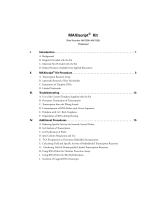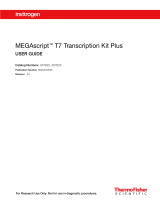Page is loading ...

PRODUCT INFORMATION
Agarase
Pub. No. MAN0012011
Rev. Date 03 May 2016 (B.00)
#EO0461 100 U
Lot: Expiry Date:
Concentration: 0.5 U/µL
Store at -20 °C
www.thermofisher.com
For Research Use Only. Not for use in diagnostic procedures.
Description
Agarase specifically digests the agarose polysaccharide
core into oligosaccharides (1). Agarase allows for gentle
yet efficient recovery of DNA or RNA fragments from low
melting point agarose. The recovered nucleic acids can be
directly used for amplification, cloning, sequencing, etc.
Applications
Quantitative recovery of DNA or RNA from low melting
point (LM) agarose gels (see protocol on back page).
Source
E.coli cells with a plasmid containing the gene encoding
-agarase from Pseudomonas atlantica.
Molecular Weight
32.7 kDa monomer.
Definition of Activity Unit
One unit of the enzyme completely degrades 100 µL
(approx. 100 mg) of molten 1% low melting point agarose
in 30 min at 42 C.
Enzyme activity is assayed in 1X TBE buffer:
89 mM Tris base, 89 mM boric acid, 2 mM EDTA.
Storage Buffer
The enzyme is supplied in: 50 mM Tris-HCl (pH 7.5),
0.1 M NaCl, 0.1% (v/v) Triton X-100 and
50% (v/v) glycerol.

Inhibition and Inactivation
Inhibitors: ethidium bromide at concentrations higher than
5 µg/mL, transition metal ions.
Inactivated by heating at 70 °C for 10 min.
Note
Activity of agarase in different buffers (in comparison to
activity in assay buffer (1X TBE)):
1X TBE (90 mM Tris-borate, 2 mM EDTA, pH 8.3) 100%
1X TAE (40 mM Tris-acetate, 1 mM EDTA, pH 8.5) 120%
1X TPE (90 mM Tris-phosphate, 2 mM EDTA, pH 7.7) 120%
1X Bis-Tris (50 mM Bis-Tris-HCl, 1 mM EDTA, pH 6.5) 150%
Conventional agarose is not suitable for digestion by
agarase.
CERTIFICATE OF ANALYSIS
Endodeoxyribonuclease Assay
Incubation of supercoiled plasmid DNA with Agarase.
Ribonuclease Assay
Incubation of RNA transcript with Agarase.
Labeled Oligonucleotide (LO) Assay
Incubation of single stranded and double stranded
radiolabeled oligonucleotides with Agarase.
Quality authorized by:
(continued on back page)

Protocol for recovery of DNA from LM agarose gels
1. Perform electrophoresis of DNA in a low melting point (LM)
agarose (#R0801) gel prepared in TAE (#B49), 0.5X TBE,
TBE (#B52) or TPE buffer. Stain the gel with ethidium bromide.
2. Cut out the desired DNA band from the agarose gel with a
clean scalpel under UV light*. Cut out only as much agarose
as necessary. (The bottom of the excised agarose slice is
free of DNA and should be removed).
3. Determine the weight of the slice. To facilitate melting, cut
gel slices larger than 200 mg into smaller pieces.
4. Incubate the tube at 70 °C for approx. 10 min. Ensure that
the agarose is completely molten.
5. Transfer the tube to a 42 °C water bath and equilibrate
for 5 min.
6. Add 1 U of Agarase (#EO0461) per 100 mg (approx. 100 µL)
of molten 1% LM agarose. Increase the amount of enzyme
proportionally for higher percentage agarose, gently mix and
incubate at 42 °C for 30 min.
7. Add ammonium acetate** to a 2.5 M final concentration, chill
on ice for 5 min.
8. Centrifuge at 10,000 rpm for 10 min to pellet undigested
carbohydrates. Transfer the supernatant to a clean tube.
9. Add 2.5 volumes of ethanol or 0.8 volume of isopropanol,
mix gently and incubate at room temperature for 1 h. If DNA
fragments are smaller than 500 kb or if the DNA
concentration is lower than 0.05 µg/mL, incubate at room
temperature for 2 h.
10. Centrifuge at 10,000 rpm for 15 min, remove supernatant
and dry the pellet. Resuspend the pellet in TE or another
appropriate buffer for subsequent manipulation.
Note
* For subcloning of gel-purified DNA fragments, care should be taken
to avoid DNA damage with UV light. minimize the UV exposure to a
few seconds or keep the gel on a glass or plastic plate during UV
illumination. Alternatively, visible dyes can be included in standard
agarose gels to visualize DNA bands in ambient light (1, 2).
** Ammonium acetate is recommended rather than other salts to
avoid co-precipitation of oligosacharides with DNA.
The procedure typically recovers 90% of DNA from the gel.
T4 Polynucleotide Kinase is inhibited by ammonium ions,
therefore use 3 M Sodium Acetate, #R1181, (0.3 M final
concentration) if T4 Polynucleotide Kinase will be used in
downstream applications.
Large DNA fragments (>30 kb) require delicate handling to
avoid mechanical shearing. After digestion with Agarase
(step 6), centrifuge at maximum speed for 10 min to pellet
undigested carbohydrates. Remove oligosacharides and
agarase by dialysis or carry out subsequent manipulations
with DNA in the digested agarose solution.

Reference
1. Yaphe, W., The use of agarase from Pseudomonas
atlantica in the identification of agar in marine algae
(Rhodophyceae), Can. J. Microbiol., 3, 987-993, 1957.
LIMITED USE LABEL LICENSE: Internal Research and Development Use Only.
The purchase of this product conveys to the buyer the limited, non-exclusive, non-
transferable right (without the right to resell, repackage, or further sublicense) to use
this product for internal research and development purposes. No other license is
granted to the buyer whether expressly, by implication, by estoppel or otherwise. In
particular, the purchase of the product does not include or carry any right or license to
use, develop, or otherwise exploit this product commercially and no rights are
conveyed to the buyer to use the product or components of the product for purposes
including but not limited to provision of services to a third party, generation of
commercial databases or clinical diagnostics. This product is sold pursuant to
authorization from Thermo Fisher Scientific and Thermo Fisher Scientific reserves all
other rights. For information on purchasing a license for uses other than internal
research and development purposes, please contact [email protected] or Out
Licensing, Life Technologies Inc., 5791 Van Allen Way, Carlsbad, California 92008.
PRODUCT USE LIMITATION
This product is developed, designed and sold exclusively for research purposes and in
vitro use only. The product was not tested for use in diagnostics or for drug
development, nor is it suitable for administration to humans or animals.
Please refer to www.thermofisher.com for Material Safety Data Sheet of the product.
© 2016 Thermo Fisher Scientific Inc. All rights reserved. All trademarks are the
property of Thermo Fisher Scientific Inc. and its subsidiaries.
/









